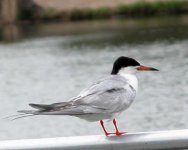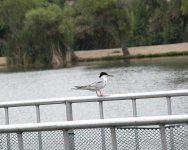-
Welcome to BirdForum, the internet's largest birding community with thousands of members from all over the world. The forums are dedicated to wild birds, birding, binoculars and equipment and all that goes with it.
Please register for an account to take part in the discussions in the forum, post your pictures in the gallery and more.
You are using an out of date browser. It may not display this or other websites correctly.
You should upgrade or use an alternative browser.
You should upgrade or use an alternative browser.
Tern ID help, please. (1 Viewer)
- Thread starter Marysan
- Start date
More options
Who Replied?Marysan said:I thought this was a Forster's Tern but I guess I'm wrong. Help, anybody? The photo was taken at Santee Lakes, CA, 07-17-03, CP 5700.
The photo didn't get uploaded so I'm trying again. Here is the pic of my Tern.
Grousemore
Senior Member
hi Marysan,why do you think you're wrong?
Looks like a Forsters to me.
Looks like a Forsters to me.

Hi Mary,
I'm not too familiar with Forsters but I think this looks like they're supposed to look!
I'm puzzled about someone putting a comment about it looking too big from a photograph in which it can't be compared in size to other known species. If they thought the structure was wrong then fair enough but overall size is very difficult to judge in a photo of a bird on its own.
I'm not too familiar with Forsters but I think this looks like they're supposed to look!
I'm puzzled about someone putting a comment about it looking too big from a photograph in which it can't be compared in size to other known species. If they thought the structure was wrong then fair enough but overall size is very difficult to judge in a photo of a bird on its own.
Michael Frankis
conehead
Another vote for Forster's here
Michael
Michael
Jane Turner
Well-known member
I have a problem that I've only seen Forster's Tern in winter plumage...where they look like Tern Shaped adult Med Gulls to me. So a couple of questions.
Those primaries look way to pale for a fresh Common Tern...but actualy darker than any Forsters I've seen. Q1 Are the flashing pale primaries of winter Forster's acquired by moult or wear?
The other thing I'm curious about. Does anyone else see trace of a dark carpal bar. It might be the way the light is reflecting off the ruffling feathers, but if not its showing the last remnants of a portlandica-type plumage. Clearly the tail and primaries are adult-type though
Q2 Has a portlandica-type plumage been recorded for Forsters. I guess its likely since Common, Arctic and Roseate all have it.
Those primaries look way to pale for a fresh Common Tern...but actualy darker than any Forsters I've seen. Q1 Are the flashing pale primaries of winter Forster's acquired by moult or wear?
The other thing I'm curious about. Does anyone else see trace of a dark carpal bar. It might be the way the light is reflecting off the ruffling feathers, but if not its showing the last remnants of a portlandica-type plumage. Clearly the tail and primaries are adult-type though
Q2 Has a portlandica-type plumage been recorded for Forsters. I guess its likely since Common, Arctic and Roseate all have it.
Michael Frankis
conehead
Hi Jane,
A1 Forster's, in late winter at least, have just completed their primary moult so have fresh white outer primary feathers which will wear to blacker slowly through spring & summer. BWP gives the primary moult as complete by Nov-Dec.
A2 First a clarification, mainly for Americans but also for younger Britons - 'portlandica' is an obsolete (and to my mind rather silly pseudo-latin!) term coined in the 1970's in Britain for the once very poorly known first-summer plumage (most terns remain in their tropical wintering grounds for their first summer, only a small proportion migrate north).
Obviously, Forster's does have a first-summer plumage, but (from Sibley's pic) it is less distinct from adult winter than the first-summer plumage of Common, etc. terns.
The apparent dark carpal bar - Forster's never has this at any age. But looking closely at the photo, I don't think this is a true feather pattern on this bird, it looks to me more like some sort of staining, whether oil or mud or what I don't know. But the sort of thing it could easily pick up on what appears to be an inland boating lake
Michael
A1 Forster's, in late winter at least, have just completed their primary moult so have fresh white outer primary feathers which will wear to blacker slowly through spring & summer. BWP gives the primary moult as complete by Nov-Dec.
A2 First a clarification, mainly for Americans but also for younger Britons - 'portlandica' is an obsolete (and to my mind rather silly pseudo-latin!) term coined in the 1970's in Britain for the once very poorly known first-summer plumage (most terns remain in their tropical wintering grounds for their first summer, only a small proportion migrate north).
Obviously, Forster's does have a first-summer plumage, but (from Sibley's pic) it is less distinct from adult winter than the first-summer plumage of Common, etc. terns.
The apparent dark carpal bar - Forster's never has this at any age. But looking closely at the photo, I don't think this is a true feather pattern on this bird, it looks to me more like some sort of staining, whether oil or mud or what I don't know. But the sort of thing it could easily pick up on what appears to be an inland boating lake
Michael
Hi all,
Firstly,I'd also like to add my vote for this bird being a Forster's Tern(despite not having seen the species in this plumage).
Secondly,re 1st-s Forster's Terns:a few of us had distant views of one this June at Our Lady's Island Lake,Co.Wexford,and it was more or less identical to 1st-w in plumage(still had an obvious black "mask",but with a dusky area on the nape)
Harry H
Firstly,I'd also like to add my vote for this bird being a Forster's Tern(despite not having seen the species in this plumage).
Secondly,re 1st-s Forster's Terns:a few of us had distant views of one this June at Our Lady's Island Lake,Co.Wexford,and it was more or less identical to 1st-w in plumage(still had an obvious black "mask",but with a dusky area on the nape)
Harry H
Jasonbirder
Jason-occasional-twitcher
We seem to have it easy over here....all of the Forsters Terns I have seen have been in winter plumage and they have been at the times of year when no Terns (or at most the odd Sandwich Tern) should be around!
Wonder how many summer plumaged Forsters Terns manage to go unnoticed on this side of the atlantic in summer amidst Arctics and Commons?
Wonder how many summer plumaged Forsters Terns manage to go unnoticed on this side of the atlantic in summer amidst Arctics and Commons?
Jane Turner
Well-known member
Plenty I would guess. We get 2000+ Commons here in summer and its a hell of an effort to even pick the single figure Arctics out of them.
Users who are viewing this thread
Total: 2 (members: 0, guests: 2)






